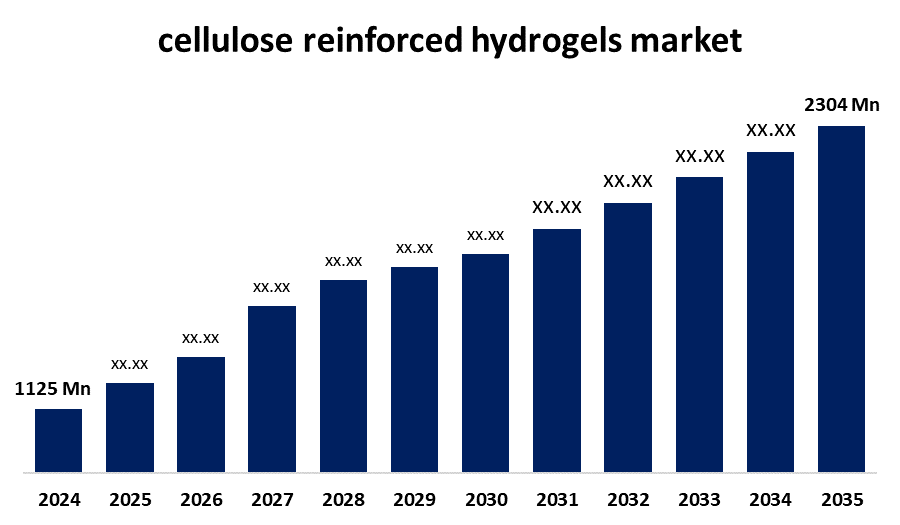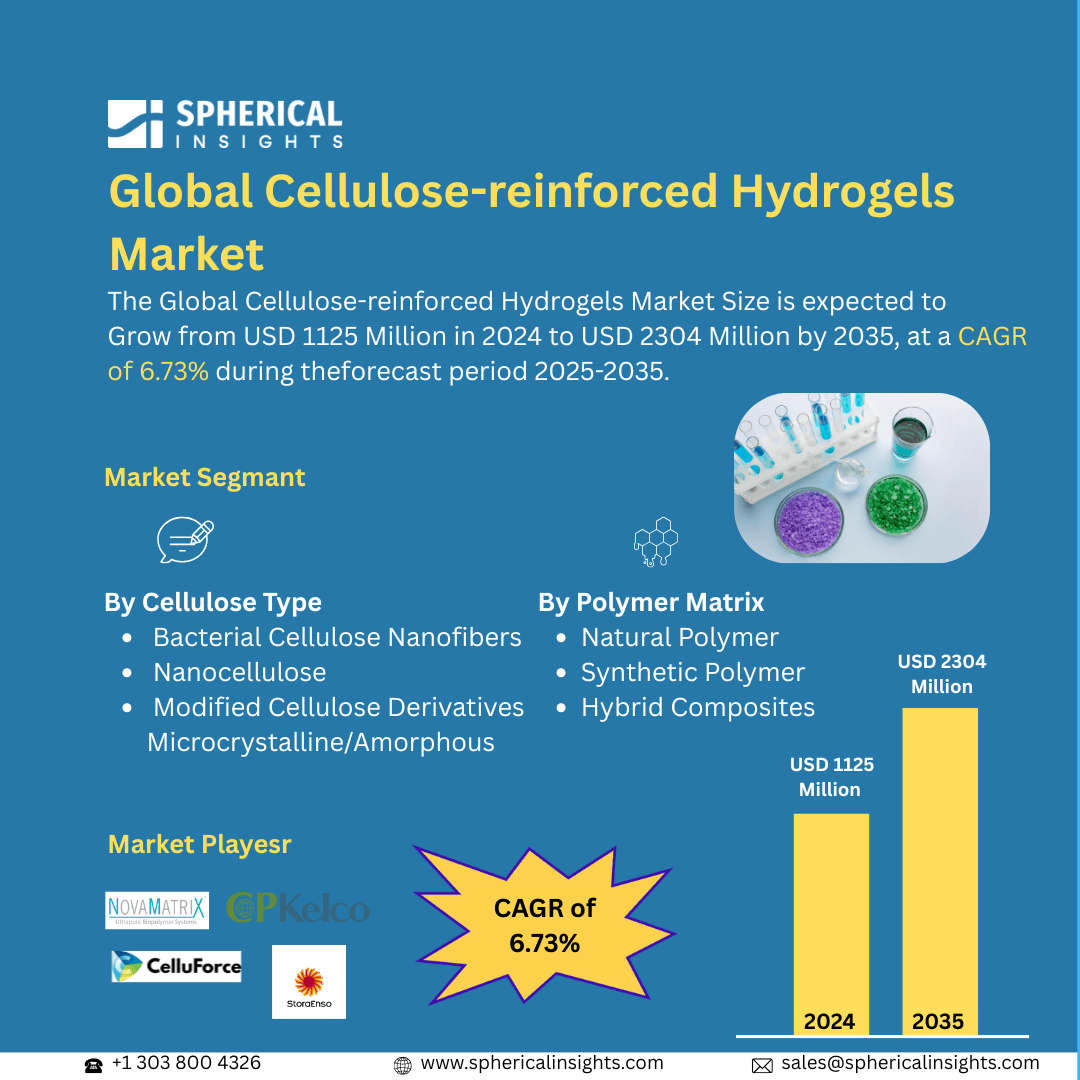Cellulose-reinforced Hydrogels Market Summary, Size & Emerging Trends
According to Spherical Insights, The Global Cellulose-reinforced Hydrogels Market Size is expected to Grow from USD 1125 Million in 2024 to USD 2304 Million by 2035, at a CAGR of 6.73% during the forecast period 2025-2035. Increasing demand for advanced biomedical, pharmaceutical, and wound care applications is a key driver for the cellulose-reinforced hydrogels market.
Key Market Insights
- Asia Pacific is expected to account for the largest share in the cellulose-reinforced hydrogels market during the forecast period.
- In terms of cellulose type, the nanocellulose segment dominated in terms of revenue during the forecast period.
- In terms of polymer matrix, the natural polymer segment accounted for the largest revenue share in the global cellulose-reinforced hydrogels market during the forecast period.
Global Market Forecast and Revenue Outlook
- 2024 Market Size: USD 1125 Million
- 2035 Projected Market Size: USD 2304 Million
- CAGR (2025-2035): 6.73%
- Asia Pacific: Largest market in 2024
- North America: Fastest growing market

Cellulose-reinforced Hydrogels Market
The cellulose-reinforced hydrogels market centers on the development of hydrophilic polymer networks enhanced with cellulose fibers to improve mechanical strength, biocompatibility, and water retention properties. These hydrogels are widely used in biomedical applications, drug delivery systems, tissue engineering, wound dressings, and agricultural sectors. Government support for biomedical research and sustainable materials, along with rising awareness of eco-friendly alternatives to synthetic hydrogels, drives market expansion. Continuous advancements in hydrogel formulations, combined with increasing demand from regenerative medicine and healthcare, position cellulose-reinforced hydrogels as a critical component in high-performance applications.
Cellulose-reinforced Hydrogels Market Trends
- Growing adoption in wound healing and tissue engineering applications due to superior biocompatibility.
- Innovations in nanocellulose integration enhancing mechanical strength and functional properties.
- Strategic partnerships and collaborations to expand production capabilities and regional presence.
Cellulose-reinforced Hydrogels Market Dynamics
Driving Factors: Increasing demand in biomedical and pharmaceutical applications
The global demand for cellulose-reinforced hydrogels is primarily fueled by their growing use in biomedical and pharmaceutical applications. These hydrogels are highly valued for their unique combination of mechanical strength, water absorption capacity, and biocompatibility, making them ideal for wound care, tissue engineering, and drug delivery systems. In drug delivery, cellulose-reinforced hydrogels can provide controlled and sustained release of therapeutic agents, improving treatment efficacy while minimizing side effects. In wound healing and tissue engineering, the hydrogels act as scaffolds that support cell growth, facilitate tissue regeneration, and maintain a moist environment conducive to healing. Moreover, the growing emphasis on sustainable and environmentally friendly materials has further strengthened their adoption, as cellulose is a natural, biodegradable polymer. Investments in research and development, particularly in regenerative medicine, have also catalyzed innovation in hydrogel formulations, enabling advanced functionalities and expanding applications across healthcare and biotechnology sectors.
Restrain Factors: High production costs and technological complexities
Despite their benefits, cellulose-reinforced hydrogels face certain limitations that may restrict market growth. The production process involves complex chemical and physical treatments to functionalize cellulose and integrate it into hydrogel networks. These processes require specialized equipment, skilled personnel, and stringent quality control, leading to high manufacturing costs. Furthermore, variations in the source and quality of cellulose can result in inconsistent properties, affecting the performance and reliability of the final hydrogel product. Large-scale production remains challenging, especially for advanced forms like nanocellulose-reinforced hydrogels. In addition, biomedical applications require regulatory approvals to ensure safety and efficacy, and obtaining these certifications can be time-consuming and costly. These factors collectively slow down widespread commercialization, particularly in price-sensitive markets.
Opportunity: Innovations in polymer matrices and cellulose types
The cellulose-reinforced hydrogels market offers significant opportunities for innovation, particularly through the development of hybrid composites and novel cellulose derivatives. Combining natural polymers with synthetic polymers allows manufacturers to tailor the mechanical, chemical, and biological properties of hydrogels to specific applications. Advances in nanocellulose and modified cellulose derivatives further enable high-performance hydrogels with improved tensile strength, porosity, and biocompatibility, ideal for regenerative medicine, drug delivery, and smart agricultural systems. Emerging economies present additional growth potential as healthcare infrastructure expands and demand for advanced biomedical materials rises. Companies focusing on research-driven innovation and product differentiation are likely to capture new market segments and establish a competitive advantage.
Challenges: Regulatory compliance and raw material availability
The development and commercialization of cellulose-reinforced hydrogels face challenges related to stringent regulatory requirements and raw material supply. Biomedical applications, such as wound care or tissue engineering, are subject to rigorous safety and efficacy standards, including approvals from organizations like the FDA or EMA. Meeting these regulatory requirements involves extensive testing, documentation, and validation, which can delay product launch and increase costs. Additionally, the market is highly dependent on the availability of high-quality cellulose sources, including bacterial cellulose, nanocellulose, and modified cellulose derivatives.
Global Cellulose-reinforced Hydrogels Market Ecosystem Analysis
The global cellulose-reinforced hydrogels ecosystem includes cellulose suppliers (bacterial cellulose producers, nanocellulose manufacturers), polymer matrix producers, hydrogel formulators, and end-users in biomedical, pharmaceutical, and agricultural sectors. Regulatory bodies enforce safety and environmental standards, while research institutions contribute to innovation. The balance of supply, technological development, and compliance drives the overall growth of the market ecosystem.
Global Cellulose-reinforced Hydrogels Market, By Cellulose Type
Nanocellulose, which includes cellulose nanocrystals (CNC) and cellulose nanofibrils (CNF), dominates the market in terms of revenue due to its high surface area, excellent mechanical reinforcement properties, and versatility in functionalization. Nanocellulose-reinforced hydrogels exhibit enhanced structural integrity, elasticity, and responsiveness, making them suitable for diverse applications beyond biomedicine, including drug delivery systems, smart agricultural hydrogels, and environmentally friendly packaging. This segment holds a leading market share of approximately 50%, driven by large-scale adoption in pharmaceutical research, tissue engineering, and emerging industrial applications. Continuous innovations in nanocellulose production and hybrid hydrogel formulations are expected to further strengthen its market position.

Bacterial cellulose nanofibers (BCNs) are highly valued in the cellulose-reinforced hydrogels market for their exceptional tensile strength, flexibility, and biocompatibility. These characteristics make BCNs ideal for biomedical applications such as wound dressings, tissue scaffolds, and implantable devices. The highly pure and uniform structure of bacterial cellulose allows for efficient water absorption and controlled drug release, which are critical in advanced wound care and tissue engineering. In terms of market share, BCNs account for approximately 40% of the global cellulose-reinforced hydrogels market, with demand primarily driven by healthcare and regenerative medicine sectors in North America, Europe, and Asia Pacific. The segment is expected to grow steadily as R&D continues to improve functionalization techniques and scalability of production.
Global Cellulose-reinforced Hydrogels Market, By Polymer Matrix
The natural polymer segment is the largest within the cellulose-reinforced hydrogels market, primarily driven by its inherent biocompatibility, biodegradability, and environmental sustainability. Hydrogels reinforced with natural polymers, such as alginate, chitosan, and gelatin, are widely used in biomedical applications, including wound healing, tissue engineering, and drug delivery systems. These hydrogels provide a favorable cellular environment for tissue regeneration while minimizing adverse immune responses, which makes them highly preferred in healthcare and pharmaceutical applications. The natural polymer segment holds approximately 55% of the global market share, reflecting strong adoption across North America, Europe, and Asia Pacific. The segment is expected to maintain steady growth due to increasing demand for eco-friendly and biologically safe materials.
Synthetic polymers, such as polyethylene glycol (PEG), polyvinyl alcohol (PVA), and polyacrylamide, provide tunable mechanical properties, precise control over swelling behavior, and enhanced stability under various conditions. These features make synthetic polymer-based cellulose-reinforced hydrogels highly suitable for advanced biomedical applications, including smart drug delivery systems, tissue scaffolding with customized mechanical properties, and responsive hydrogels for controlled release. The synthetic polymer segment accounts for approximately 35% of the market, supported by ongoing research in hybrid composites and functionalized polymer matrices. Growth in this segment is further accelerated by the development of next-generation hydrogels tailored for specific biomedical and pharmaceutical needs.
Asia Pacific is expected to account for the largest share of the cellulose-reinforced hydrogels market, holding approximately 45% of global revenue. The region’s dominance is driven by significant investments in biomedical research, expanding healthcare infrastructure, and increasing adoption of advanced wound care and tissue engineering solutions in countries such as China, India, and Japan. Rapid industrialization, government initiatives supporting biotechnology and regenerative medicine, and rising awareness of sustainable materials further fuel market growth. Additionally, the growing number of academic and industrial collaborations in the region accelerates innovation in cellulose-reinforced hydrogel applications.
North America is anticipated to register the fastest CAGR of approximately 9% during the forecast period. The rapid growth is driven by high adoption in advanced medical applications, including smart drug delivery systems, regenerative medicine, and personalized healthcare solutions. Strong pharmaceutical and biotechnology R&D activities, well-established healthcare infrastructure, and early adoption of innovative hydrogel technologies contribute to the region’s accelerated growth. The U.S. and Canada remain the primary contributors to market expansion in North America.
Europe holds an estimated 15% share of the global cellulose-reinforced hydrogels market, showing steady growth supported by increasing healthcare infrastructure, research collaborations, and rising demand for biocompatible and sustainable materials. Countries like Germany, the UK, and France lead in clinical research and adoption of advanced biomedical hydrogel solutions. The presence of strong regulatory frameworks ensures quality and safety, supporting market stability.
WORLDWIDE TOP KEY PLAYERS IN THE CELLULOSE-REINFORCED HYDROGELS MARKET INCLUDE
- NovaMatrix (FMC Biopolymer)
- CPKelco
- Celluforce
- Stora Enso
- DuPont
- Ashland
- Nippon Paper Industries Co., Ltd.
- UPM-Kymmene
- Others
Product Launches in Cellulose-reinforced Hydrogels Market
- In March 2024, NovaMatrix introduced a next-generation nanocellulose-reinforced hydrogel specifically designed for wound care applications. This advanced hydrogel offers enhanced moisture retention, which promotes faster healing and maintains an optimal environment for tissue regeneration. Additionally, the hydrogel demonstrates improved mechanical strength, ensuring better durability and flexibility during application.
Market Segment
This study forecasts revenue at global, regional, and country levels from 2020 to 2035. Decision Advisor has segmented the cellulose-reinforced hydrogels market based on the below-mentioned segments:
Global Cellulose-reinforced Hydrogels Market, By Cellulose Type
- Bacterial Cellulose Nanofibers
- Nanocellulose
- Modified Cellulose Derivatives
- Microcrystalline/Amorphous
Global Cellulose-reinforced Hydrogels Market, By Polymer Matrix
- Natural Polymer
- Synthetic Polymer
- Hybrid Composites
Global Cellulose-reinforced Hydrogels Market, By Regional Analysis
- North America
- Europe
- Germany
- UK
- France
- Italy
- Spain
- Russia
- Rest of Europe
- Asia Pacific
- China
- Japan
- India
- South Korea
- Australia
- Rest of Asia Pacific
- South America
- Brazil
- Argentina
- Rest of South America
- Middle East & Africa
- UAE
- Saudi Arabia
- Qatar
- South Africa
- Rest of the Middle East & Africa





